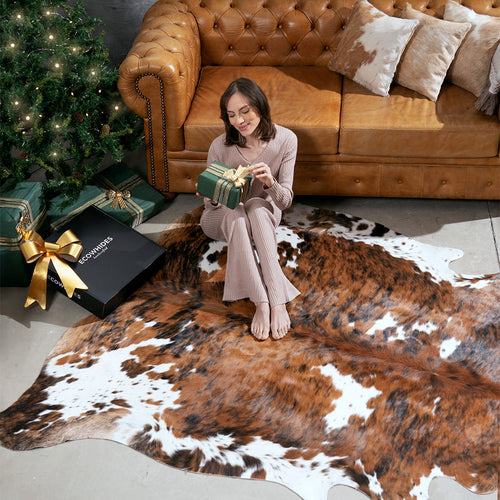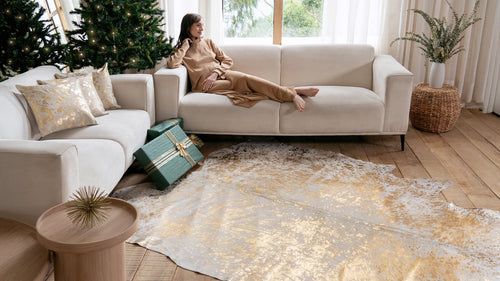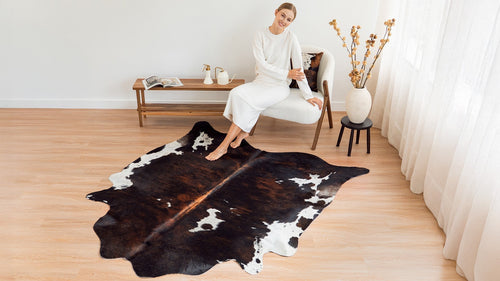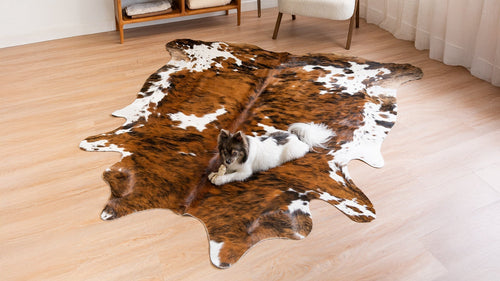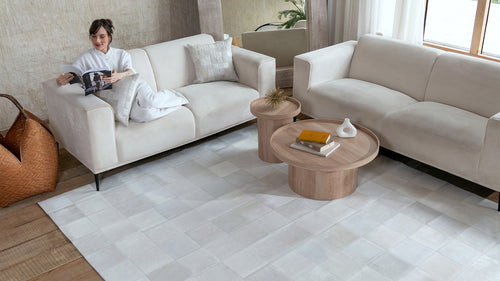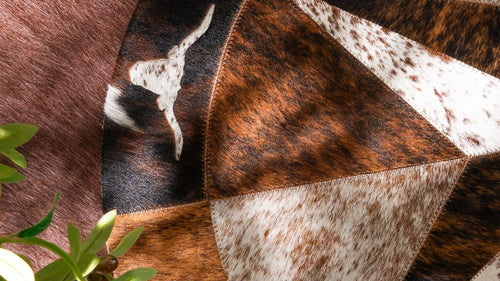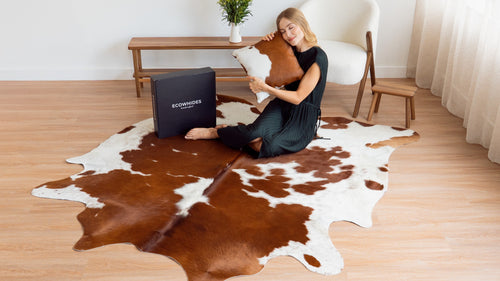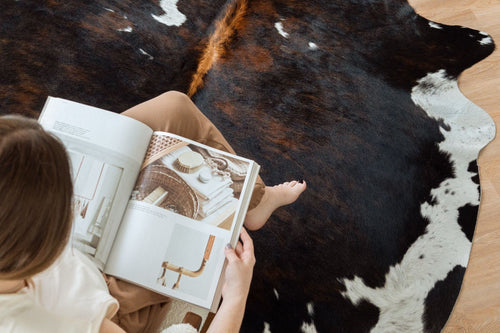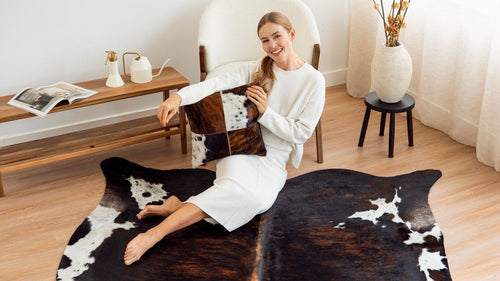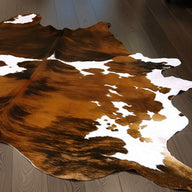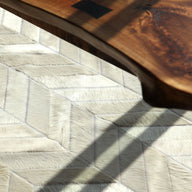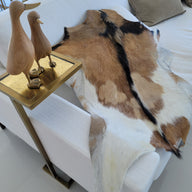Have you ever run your fingers across what you thought was a Genuine Cowhide Rug, only to question if it's the real deal? You're not alone. At eCowhides, we’ve heard this concern from plenty of customers. Telling the difference between authentic and faux hide rugs can be surprisingly tricky—especially with so many lookalikes on the market.
The industry is flooded with synthetic alternatives that mimic the look of Real Cowhide, but nothing quite captures the unique character and longevity of the genuine article. Whether you're considering your first purchase or looking to verify one you already own, this guide will equip you with expert knowledge to spot Authentic Cow Hide Rugs with confidence.

Why Knowing the Difference Matters
Before diving into identification methods, let's talk about why this matters. A Genuine Cowhide is more than just a decorative piece—it's an investment in natural beauty, durability, and timeless style. Natural Cowhide Rug typically lasts for decades when properly cared for, while synthetic alternatives often need replacement after just a few years.
Plus, there's something undeniably special about bringing a piece of natural craftsmanship into your home. Each Hide Rug tells a story through its unique pattern, texture, and character—something mass-produced replicas simply cannot offer.
1. Texture Check: Feel the Real Deal
When I'm working with customers to find that just-right rug, I always encourage them to trust their sense of touch. Genuine Cowhide has a distinctive feel that's difficult to replicate artificially.
The hair on a Real Cowhide Rug is actual hair, not synthetic fibers. This means it will have natural variations in texture—some areas might feel slightly coarser, others softer. Run your hand against the grain and then with it; you'll notice the hair lies in a consistent direction and bounces back when disturbed.

Here's what to pay attention to:
- Hair texture variation: Natural Cow Hide has subtle differences in texture across the surface. Some spots may be silkier, others slightly more bristly.
- Hair length: Authentic Cowhide hair varies slightly in length—it wasn't trimmed by a machine to perfect uniformity.
- The burn test: If you're serious about verification (and own the rug), carefully trim a tiny amount of hair from an inconspicuous area. If it’s legit, it will smell like burning hair when singed, while synthetic fibers melt like plastic and emit a chemical odor.
I had a customer come to me sharing stories of buying what she believed were genuine Black and White Cowhide Rugs online, only to be disappointed when the rugs arrived with a suspiciously uniform texture—an obvious sign of synthetic material. Real Cowhide has a natural character you can feel.
2. The Flip Side: Is Your Cowhide Backing Legit?
The surest way to identify an Authentic Cow Hide Rug is often to look at what you can't normally see—the back side. This is where manufacturers of faux Cowhides have the hardest time replicating the real thing.
A Genuine Cowhide has a distinctive suede-like backing with a slightly fuzzy texture. You'll notice small pores where hair follicles once grew. The backing should feel soft but substantial, with some natural variation in thickness.

Key indicators of an authentic backing include:
- Natural leather appearance: The backing of Real Cowhide looks like natural suede leather, with subtle color variations.
- Visible pores: Look for tiny holes where the hair grows through the hide.
- Organic shape: Authentic Cowhide Rugs have irregular, natural edges rather than perfectly symmetrical outlines.
- No fabric or mesh reinforcement: Synthetic rugs often have visible fabric backing or mesh reinforcement.
The backing of a faux Hair on Hide typically reveals its true nature through a perfectly uniform texture.
3. The Sniff Test: How Real Cowhide Should Smell
This might sound unusual, but your nose is a powerful tool for authentication. Genuine Cowhide has a subtle, natural leather scent—not overpowering, but distinctly organic. This leather aroma becomes more noticeable when you run your hand against the grain of the hair, warming the hide slightly.
Synthetic materials, by contrast, often have a chemical or plastic smell, especially when new. Even with added fragrances designed to mimic leather, there's usually an underlying artificial note that's hard to disguise.
The natural scent of leather comes from the tanning process and the Hide itself. While the smell should be present, it should never be overwhelming or unpleasant—a strong, chemical odor is a red flag for synthetic materials or poor-quality processing.
I've found the scent test particularly useful when going through Cowhide Rugs, which often have a distinctive, pleasant leather aroma that speaks to their quality tanning process.
4. Natural Markings Are a Good Thing
In the world of mass-produced perfection, it's easy to mistake flaws for defects. With Cowhide Rugs, however, natural markings are actually signs of authenticity rather than problems to avoid.

Nature doesn't create perfect patterns, and Genuine Cowhide reflect this beautiful truth:
- Unique color patterns: Authentic Hides display natural color transitions and irregular pattern distribution.
- Growth marks and brands: Small scars, subtle stretch marks, or even the occasional brand mark tell the story of the animal's life and add unique character to your rug.
-
Color variations: Natural variations in shade and tone across the hide indicate you're looking at a genuine article.
I once had a client who was disappointed to find what looked like a scar on her new Vintage Cowhide Rug. After explaining that this natural marking actually confirmed its authenticity and made her piece unique, she came to see it as one of the rug's most cherished features.
Rustic Cowhide Rugs with distinctive markings are especially valuable for their character and the stories they tell. Remember, in a Genuine Cowhide Rug, these imperfections are perfect.
5. Tough as Leather
Real Cowhide is strong, flexible, and doesn't fray at the edges like faux alternatives. This durability is one of the most compelling reasons to invest in an Authentic Cowhide Rug.

To test durability and flexibility:
- The fold test: Pick up a corner of the rug and let it fold naturally. A Genuine Cowhide drapes organically with gentle, uneven folds. It has flexibility while maintaining structure and feels substantial in weight.
- Edge examination: Check the edges for fraying or separation. Real Cowhide edges should be solid and intact, not peeling or coming apart.
- Resilience: Press your hand firmly into the rug, then remove it. A Real Cowhide Rug will quickly bounce back to its original shape.
I have one of our Tricolor Cowhides in my home's entryway that has withstood three years of heavy foot traffic, occasional pet claws, and even a few small spills—yet it still looks remarkable. This kind of longevity is simply unmatched by synthetic alternatives.
For high-traffic areas, nothing beats the natural durability of a quality Brazilian Cowhide Rugs. While the initial investment might be higher than synthetic options, the years of beautiful service make Authentic Cowhide Rugs the better value by far.
Price Point Perspective
While not a physical test, the price can be telling. Quality Brazilian Cowhide Rugs typically range from $200-$700 for a standard size (approximately 7x6 feet), depending on rarity, pattern, and quality. If you're seeing prices significantly below this range for what's advertised as a "genuine" Cowhide Rug, you might be looking at a synthetic alternative or a lower-quality hide.
Documentation and Certification

Reputable sellers of Genuine Cowhide Rugs, typically provide documentation about their products' origins. Look for:
- Leather Working Group certification
- Information about traceability
- Details about the tanning process
- Country of origin (Brazil and Colombia are highly regarded for their leather quality)
How to Care for Your Genuine Cowhide Rug
Once you've invested in an Authentic Cowhide, proper care will ensure it remains beautiful for decades:
- Regular maintenance: Shake or vacuum gently (without beater bar) once or twice monthly
- Spill response: Blot immediately with a clean, dry cloth—never rub
- Rotation: Turn your rug 180° every few months to ensure even wear
- Spot cleaning: Use a damp cloth with mild soap for small stains, then blot dry
- Professional cleaning: For deep cleaning, always use a leather specialist
Styling Your Authentic Cowhide Rug

A Genuine Cowhide Rug works beautifully in various design contexts:
- Rustic decor: Pairs perfectly with reclaimed wood, natural stone, and wrought iron
- Modern spaces: Creates organic contrast against clean lines and minimalist furniture
- Eclectic rooms: Adds texture and pattern that complements diverse decor elements
- Layering: Works wonderfully layered over larger jute or sisal rugs for dimensional interest
I've seen how our Cowhides transform the homes of our customers in surprising ways—even those with more modern tastes have found that a subtle, Natural Cowhide Rug adds unexpected warmth to their homes.
Making the Right Choice for Your Home
Choosing between real and faux Cowhide ultimately depends on your values, budget, and design preferences. For the eco-conscious consumer, look for Certified Sustainable Cowhide Rugs that utilize byproducts of the food industry.
Whatever you choose, being able to identify Authentic Cowhide ensures you'll get exactly what you're paying for—whether that's the genuine article or a quality synthetic alternative.
FAQ: Genuine Cowhide Edition
Are Cowhide Rugs ethical?
Ethical Cowhide Rugs are byproducts of the meat industry. Choose Leather Working Group certified rugs from traceable sources like eCowhides to ensure responsible sourcing.
How durable are Genuine Cowhide Rugs in high-traffic areas?
Extremely durable. Real Cowhide maintains its appearance even with heavy foot traffic, making it ideal for entryways and living rooms. Darker hides conceal soil better over time.
Are Cowhide Rugs hypoallergenic?
Yes. Natural Cowhide Rugs are hypoallergenic because the tanning process removes allergens. They don't trap dust or harbor dust mites like synthetic rugs, making them excellent for allergy sufferers.
How do I clean a Genuine Cowhide Rug?
Vacuum gently (no beater bar), shake occasionally, and blot spills immediately with a dry cloth. For spot cleaning, use a slightly damp cloth with mild soap. Never saturate the hide with water.
How long do Real Cowhide Rugs last?
With proper care, Genuine Cowhide Rugs last more than a decade, making them an excellent investment compared to synthetic alternatives that typically need replacement after 2-3 years.

Conclusion: The Timeless Appeal of Authentic Cowhide
There's something undeniably special about bringing an authentic piece of natural craftsmanship into your home. A Genuine Cowhide Rug connects your space to Western tradition while adding unique texture and organic beauty that mass-produced alternatives simply cannot match.
Armed with the knowledge to identify Real Cowhide Rugs, you can shop with confidence and invest in a piece that will enhance your home for years to come. Remember—Real Cow Hide embraces natural variation, feels substantial, drapes beautifully, and improves with age.
Have you discovered the perfect Cowhide Rug for your space? Or do you have questions about authenticating a particular piece? We’ll be more than happy to assist you, reach out to us!






















